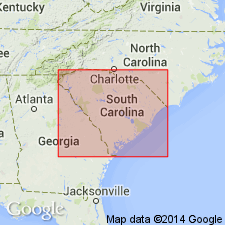
- Usage in publication:
-
- Parachucla phase
- Modifications:
-
- Named
- Dominant lithology:
-
- Marl
- Shale
- AAPG geologic province:
-
- South Georgia sedimentary province
- Atlantic Coast basin
Summary:
The Parachucla phase (of the author's Oligocene period) is made to comprise a marl and its immediately overlying shale. The Parachucla marl has been definitely discriminated at two points --Porters Landing, GA, and Marl Lake. It consists of approximately 5 ft of a light-yellow porous marl, which includes numerous discoidal quartz pebbles, and fossil shells (notably CAROLIA FLORIDANBA). It rests on undulating surface of Combahee shales [a facies of Alum Bluff]. The Parachucla shales are exposed along the western bank of Savannah River discontinuously from Marl Lake to vicinity of Purysburg. They are well exhibited at Porters Landing overlying the Parachucla marls and underlying the Marks Head marl, on which is superimposed the Edisto phase of the marl. The Parachucla shales constitute an alumino-siliceous shale, more or less indurated by siliceous solutions, and slightly stratified. In color they range from dove to dark gray. The mass includes indurated portions with a concentric structure. No fossil forms sufficiently defined for discrimination have been observed.
Source: GNU records (USGS DDS-6; Reston GNULEX).
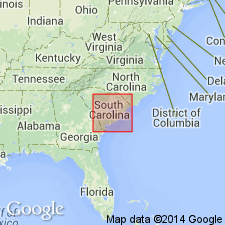
- Usage in publication:
-
- Parachucla beds†
- Modifications:
-
- Abandoned
- AAPG geologic province:
-
- Atlantic Coast basin
Summary:
Parachucla beds are lower Miocene, not Oligocene, and compose part of the Hawthorn formation. Names are abandoned.
Source: GNU records (USGS DDS-6; Reston GNULEX).
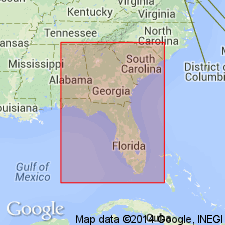
- Usage in publication:
-
- Parachucla Formation
- Modifications:
-
- Reinstated
- Revised
- AAPG geologic province:
-
- Atlantic Coast basin
Summary:
Parachucla Formation is here assigned to the Hawthorn Group in eastern SC. Underlies Marks Head Marl. Age is Early Miocene.
Source: GNU records (USGS DDS-6; Reston GNULEX).
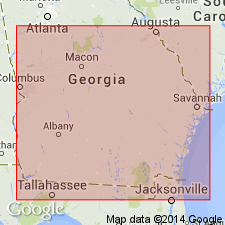
- Usage in publication:
-
- Parachucla Formation
- Modifications:
-
- Principal reference
- Revised
- AAPG geologic province:
-
- Atlantic Coast basin
- South GA-North FL sedimentary province
Summary:
Parachucla Formation of Sloan (1908), the lowest and oldest formation of the Hawthorne Group, is here expanded and revised. A principal reference locality is designated at Porters Landing, on the Savannah River, Effingham Co. The core Effingham 10 (GGS-3108) is designated as an additional reference section. The unit is divided into a lower Tiger Leap Member (new name), originally referred to the Combahee phase by Sloan (1908), and an upper Porters Landing Member (new name), which encompasses both the Parachucla marl and the Parachucla shale as defined by Sloan (1908). The formation underlies the eastern Coastal Plain of GA and extends northward into SC, southward into northeastern FL, and southwestward into the Gulf Trough. Unit generally disconformably overlies the Suwannee Limestone in GA, but in places, disconformably overlies the Crystal River or Lazaretto Creek Formations. Disconformably underlies the Marks Head Formation in most areas and the Pliocene Cypresshead Formation (new name) only in northernmost Effingham and southern Screven Cos. Greatest known thickness in its type area is 120 ft (37 m) in the Effingham 10 core. Reaches 325 ft (99 m) in northeastern Colquitt Co., GA. Depositional environment is marine, continental shelf, inner to middle neritic. Age is early Miocene (Aquitanian) based on planktonic foraminiferal assemblages.
Source: GNU records (USGS DDS-6; Reston GNULEX).
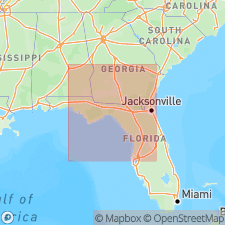
- Usage in publication:
-
- Parachucla Formation
- Modifications:
-
- Geochronologic dating
- AAPG geologic province:
-
- Florida platform
Summary:
Authors use 87Sr/86Sr isotopic analyses in an attempt to resolve age relations of fossiliferous marine units that contain the remains of terrestrial vertebrates. Nearly identical, latest Oligocene ages were calculated for samples from the Penney Farms Formation in Marion Co. (24.6 Ma) and the Parachucla Formation at White Springs in Hamilton Co. (24.4 Ma). The strata at White Springs has been correlated with the Porters Landing Member of the Parachucla, but a sample from the type locality of the Porters Landing in GA yielded a much younger age of 20.2 Ma.
Source: GNU records (USGS DDS-6; Reston GNULEX).
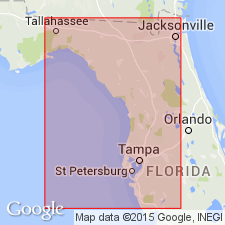
- Usage in publication:
-
- Parachucla Formation
- Modifications:
-
- Biostratigraphic dating
- AAPG geologic province:
-
- Florida platform
Summary:
The Parachucla, exposed along the Suwannee River near White Springs in Columbia and Hamilton Cos., in northernmost peninsular FL has been considered very early Miocene (Aquitanian) in age on the basis of planktonic Foraminifera from correlative strata in GA. The White Springs Local Fauna is derived from the Parachucla and contains several land mammals typical of the early Arikareean. Therefore, the Parachucla may be in part latest Oligocene (late Chattian). The Tampa Member of the Arcadia also contains fauna that is Arikareean and so the correlation of the Parachucla and Tampa proposed by Scott (1988) is corroborated.
Source: GNU records (USGS DDS-6; Reston GNULEX).
For more information, please contact Nancy Stamm, Geologic Names Committee Secretary.
Asterisk (*) indicates published by U.S. Geological Survey authors.
"No current usage" (†) implies that a name has been abandoned or has fallen into disuse. Former usage and, if known, replacement name given in parentheses ( ).
Slash (/) indicates name conflicts with nomenclatural guidelines (CSN, 1933; ACSN, 1961, 1970; NACSN, 1983, 2005, 2021). May be explained within brackets ([ ]).

